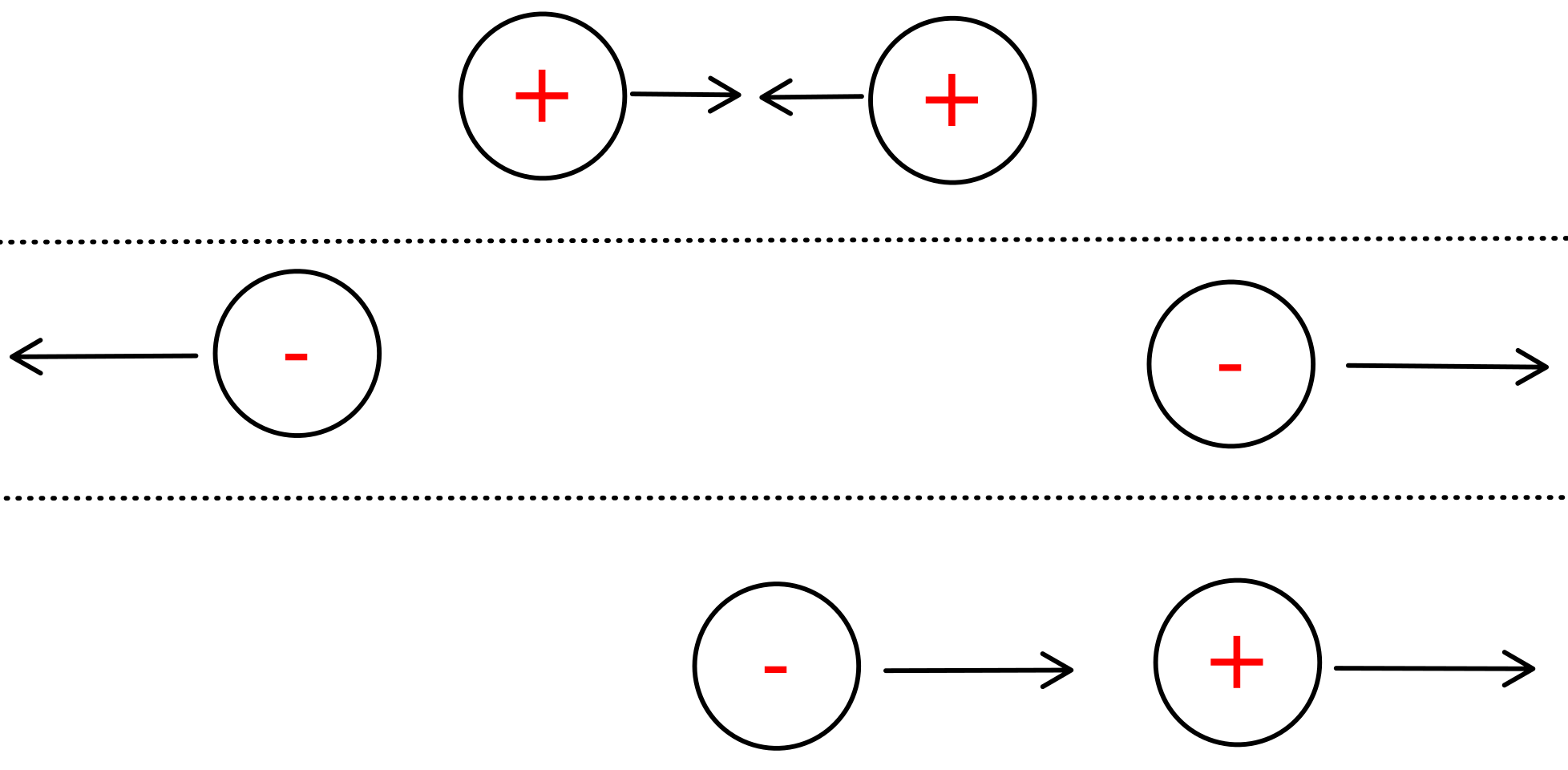Negative mass! Bwaaa, so bizarre! But is it really? One way to think about mass is as a charge for the gravitational force. If electric charges can have both positive and negative signs, is it such a stretch to imagine positive and negative gravitational charges? Well kinda, yeah. Many years ago, it was shown (Bondi, 1957) that taking account of general relativity, objects with negative mass would behave very strangely indeed! The intuitive description is that in GR, objects with positive mass always attract everything, and objects with negative mass always repel everything, so together, a pair of the two would just chase each other forever. Here is an illustration:
Positive and negative masses in Einstein's gravity. In ordinary flat space, two positive masses attract each other, two negative masses repel each other, and a negative mass and positive mass would chase each other forever.
So what more is there to say about these things, why revive the topic? Well recently (Belletête & Paranjape, 2013; Johnson et al., 2020) it was shown that in a universe with dark energy, it’s possible to construct an object that looks like it has negative mass, from far away. These “bubbles” are fundamentally very different from the simple point charges considered before, and their existence is intimately linked to the dark energy (and the exponential expansion of the universe that it induces). The point of this research project is to really explore these bubbles, to see how they behave mechanically, and very importantly, to see how they would have behaved in the early universe, and whether or not they would have left a detectable signal.
Questions to ask:
- How does the classic calculation (Bondi, 1957) change if space is permeated with a dark energy (and so is exponentially expanding)?
- What are the scales involved? Is there a limit on how big or small the bubbles can be?
- What about the very early universe, where there was a sort of dark energy due to a quantum field (the inflaton)? Could quantum fluctuations have formed bubbles like these, and if so, could there be a trace of them in the sky?
References
2020
-
Stable, Thin Wall, Negative Mass Bubbles in de Sitter Space-Time
Matthew C. Johnson, M. B. Paranjape, Antoine Savard, and Natalia Tapia-Arellano
General Relativity and Gravitation, Aug 2020
Negative mass makes perfect physical sense as long as the dominant energy condition is satisfied by the corresponding energy-momentum tensor. Heretofore, only configurations of negative mass had been found (Belletête and Paranjape in Int J Mod Phys D 22:1341017, 2013; Mbarek and Paranjape in Phys Rev D 90:101502, 2014), the analysis did not address stability or dynamics. In this paper, we analyze both of these criteria. We demonstrate the existence of stable, static, negative mass bubbles in an asymptotically de Sitter space-time. The bubbles are solutions of the Einstein equations and correspond to an interior region of space-time containing a specific mass distribution, separated by a thin wall from the exact, negative mass Schwarzschild-de Sitter space-time in the exterior. We apply the Israel junction conditions at the wall. For the case of an interior corresponding simply to de Sitter space-time with a different cosmological constant from the outside space-time, separated by a thin wall with energy density that is independent of the radius, we find static but unstable solutions which satisfy the dominant energy condition everywhere. The bubbles can collapse through spherically symmetric configurations to the exact, singular, negative mass Schwarzschild-de Sitter solution. Interestingly, this provides a counter-example of the cosmic censorship hypothesis. Alternatively, the junction conditions can be used to give rise to an interior mass distribution that depends on the potential for the radius of the wall. We show that for no choice of the potential, for positive energy density on the wall that is independent of the radius, can we get a solution that is non-singular at the origin. However, if we allow the energy density on the wall to depend on the radius of the bubble, we can find stable, static, non-singular solutions of negative mass which everywhere satisfy the dominant energy condition.
2013
-
On negative mass
Jonathan Belletête, and M. B. Paranjape
Int.J.Mod.Phys., Aug 2013
The Schwarzschild solution to the matter free, spherically symmetric Einstein equations has one free parameter, the mass. But the mass can be of any sign. What is the meaning of the negative mass solutions? The answer to this question for the case of a pure Schwarzschild negative mass black solution is still elusive, however, in this essay, we will consider negative mass solutions within a Schwarzschild-de Sitter geometry. We show that there exist reasonable configurations of matter, bubbles of distributions of matter, that satisfy the dominant energy condition everywhere, that are non-singular and well behaved everywhere, but correspond to the negative mass Schwarzschild-de Sitter geometry outside the matter distribution. These negative mass bubbles could occur as the end state of a quantum tunnelling transition.
1957
-
Negative Mass in General Relativity
H. Bondi
Rev. Mod. Phys., Jul 1957
Publisher: American Physical Society
